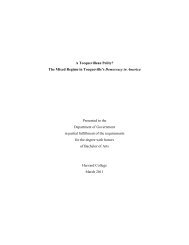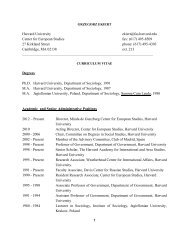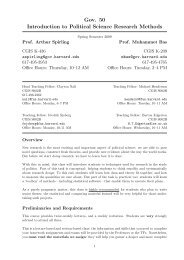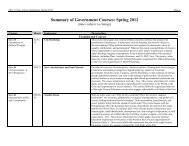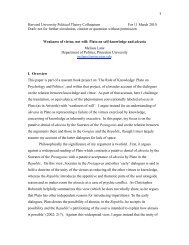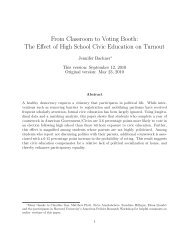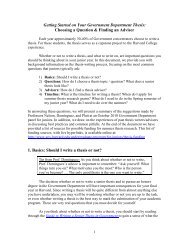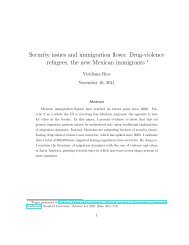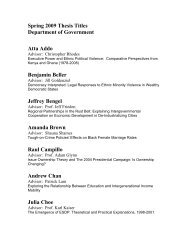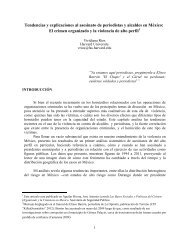Supreme Court Agenda Setting in a System of Shared Powers Ryan ...
Supreme Court Agenda Setting in a System of Shared Powers Ryan ...
Supreme Court Agenda Setting in a System of Shared Powers Ryan ...
Create successful ePaper yourself
Turn your PDF publications into a flip-book with our unique Google optimized e-Paper software.
10 The Journal <strong>of</strong> Law, Economics, & Organization. V0 N0<br />
Because the <strong>Court</strong> has taken a status quo policy and made it worse for the political<br />
branches, they will respond with override legislation that sets new policy<br />
somewhere on LR. Because the policy result<strong>in</strong>g from this override would represent<br />
a policy loss for the <strong>Court</strong>—as well as damage to its legitimacy—the<br />
<strong>Court</strong> will deny review to the case. 11<br />
Regime 3 shows a semi-constra<strong>in</strong>ed <strong>Court</strong>. In this regime, the <strong>Court</strong>’s ability<br />
to set policy is dependent on the pivots’ preferred-to sets. Look first at SQ 1 .<br />
Assume that the <strong>Court</strong> is represented by J 1 . In this example, the <strong>Court</strong> could<br />
set policy at its ideal po<strong>in</strong>t because it falls with<strong>in</strong> both pivots’ preferred-to sets<br />
relative to SQ 1 . That is, the <strong>Court</strong>’s new policy would be an improvement for<br />
both the Left and the Right Pivots. Now, however, assume that after personnel<br />
change, the <strong>Court</strong> median is represented by J 2 . If the <strong>Court</strong> tried to set policy<br />
at J 2 , its decision would be vulnerable to a legislative override. To be sure,<br />
sett<strong>in</strong>g policy at J 2 would make the Right Pivot better <strong>of</strong>f. Nevertheless, the<br />
policy shift would be worse for the Left Pivot. In response, the Left Pivot<br />
would propose legislation somewhere on LR that makes it and the Right Pivot<br />
better <strong>of</strong>f than J 2 . Anticipat<strong>in</strong>g this response, the <strong>Court</strong> would simply render<br />
its decision at SQ L 1 ∗ . This is the location <strong>in</strong> policy space that makes R and<br />
J 2 better <strong>of</strong>f, and L no worse <strong>of</strong>f than SQ. Even though the <strong>Court</strong> cannot set<br />
policy at J 2 , its policy decision at SQ L 1 ∗ still reflects a net policy ga<strong>in</strong> for the<br />
<strong>Court</strong>. As such, it would vote to grant review.<br />
Now, assume that the status quo is SQ 2 rather than SQ 1 and that the <strong>Court</strong>’s<br />
median is aga<strong>in</strong> J 1 . The <strong>Court</strong> <strong>in</strong> this scenario would be forced to render a decision<br />
at R. If the <strong>Court</strong> rendered a decision at J 1 , it would, <strong>of</strong> course, improve<br />
policy for the Right Pivot but make a worse policy for the Left Pivot. In response,<br />
the Left Pivot would propose override legislation somewhere on LR.<br />
S<strong>in</strong>ce the legislation L strategically proposes will always be better for R, R<br />
would agree to the override. To avoid this response, the <strong>Court</strong> would be forced<br />
to render a decision on the merits at R. As this is the Right Pivot’s ideal po<strong>in</strong>t,<br />
noth<strong>in</strong>g L proposes would lead R to move policy away from the <strong>Court</strong>’s decision.<br />
The <strong>Court</strong>’s policy, then, survives any override attempt. In the end, while<br />
the <strong>Court</strong> cannot set policy at its ideal po<strong>in</strong>t (either J 1 or J 2 ), the equilibrium<br />
policy it adopts nevertheless will be an improvement for the <strong>Court</strong>. Consequently,<br />
it will grant review to cases <strong>in</strong> this regime.<br />
Regime 4 also shows a semi-constra<strong>in</strong>ed <strong>Court</strong>. Look first at a <strong>Court</strong> whose<br />
median is J 1 . If the <strong>Court</strong> rendered a decision at J 1 , it would make both legislative<br />
pivots worse <strong>of</strong>f than the status quo and they, <strong>in</strong> turn, would pass override<br />
legislation (which could, quite conceivably be worse than the exist<strong>in</strong>g status<br />
quo for the <strong>Court</strong>). 12 The <strong>Court</strong> at J 1 , then, would be constra<strong>in</strong>ed to render a<br />
11. Of course, the <strong>Court</strong> could grant review and set policy just to the right <strong>of</strong> SQ (a po<strong>in</strong>t<br />
with<strong>in</strong> both pivots’ preferred-to sets). While a majority <strong>of</strong> the <strong>Court</strong> is not likely to grant review<br />
<strong>in</strong> this type <strong>of</strong> case because it would make worse policy for them, a m<strong>in</strong>ority <strong>of</strong> justices us<strong>in</strong>g<br />
the Rule <strong>of</strong> Four could force the case on the <strong>Court</strong>’s docket to <strong>in</strong>duce such a shift. Nevertheless,<br />
these four justices would be little assuaged by the grant s<strong>in</strong>ce the <strong>Court</strong> would only shift policy<br />
marg<strong>in</strong>ally. They are not likely to waste their resources on such a trivial policy shift.<br />
12. Even if the policy that results from the override is better for the <strong>Court</strong> than the status quo,



